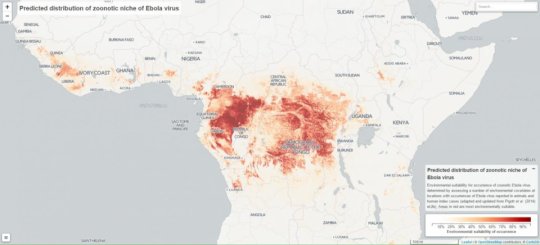
Though the West African Ebola outbreak that began in 2013 is now under control, 23 countries remain environmentally suitable for animal-to-human transmission of the Ebola virus. Only seven of these countries have experienced cases of Ebola, leaving the remaining 16 countries potentially unaware of regions of suitability, and therefore underprepared for future outbreaks.
These findings come from a new study published in the journaleLife titled “Updates to the zoonotic niche map of Ebola virus disease.” The paper was led by researchers from the Institute for Health Metrics and Evaluation (IHME) at the University of Washington in Seattle.
Only a handful of countries saw cases of Ebola before 2013, until Guinea unexpectedly reported an outbreak that led to more than 28,000 cases and 11,000 deaths across West Africa. The currenteLife study provides an update on a study published in 2014 that created a zoonotic niche map used to define areas of environmental suitability for Ebola in response to the outbreak. This map identified regions where the virus could be transmitted from animals to humans. The updated map published today incorporates more species of bats likely capable of transmitting Ebola, as well as new reports of the virus.
Alongside the current study and update, IHME launched a new, online data visualization tool, available to stakeholders and the public.
“The visualization tool provides an important way for various end users to engage and interrogate these updated maps,” explains the paper’s lead author Dr. David Pigott, an Assistant Professor at IHME. “Unlike with the previous publication, anyone can now directly interact with the maps, use the tool, and better assess the potential threat that Ebola virus disease poses to their regions of interest.”
The tool allows users to view previous Ebola index cases, as well as explore the areas where bat species thought to be capable of transmitting the virus are predicted to live. The maps are displayed in a 5-by-5 km grid across Africa, allowing users to zoom into their countries to see areas of interest. This type of geospatial mapping tool is the first of its kind from IHME.
In countries where an Ebola outbreak is possible, the update and new data visualization are powerful tools that allow decision-makers to set policies to prepare for potential outbreaks in the future.
Story Source:
The above post is reprinted from materials provided by Institute for Health Metrics and Evaluation. Note: Materials may be edited for content and length.
Journal Reference:
- David M Pigott, Anoushka I Millear, Lucas Earl, Chloe Morozoff, Barbara A Han, Freya M Shearer, Daniel J Weiss, Oliver J Brady, Moritz UG Kraemer, Catherine L Moyes, Samir Bhatt, Peter W Gething, Nick Golding, Simon I Hay.Updates to the zoonotic niche map of Ebola virus disease in Africa. eLife, 2016; 5 DOI: 10.7554/eLife.16412
